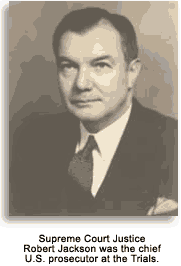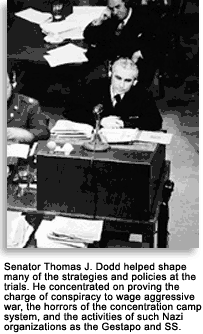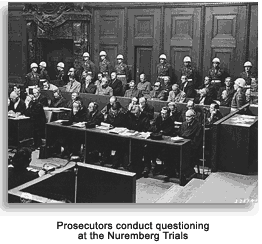The Nuremberg Trials is the general name for two sets of trials of Nazis involved in crimes committed during The Holocaust of World War II. The first, and most famous, began on November 20, 1945. It was entitled the Trial of the Major War Criminals before the International Military Tribunal, which tried the most important leaders of Nazi Germany. The second set of trials, for lesser war criminals, was conducted under Control Council Law No. 10, at the U.S. Nuremberg Military Tribunals.
Several times during World War II, the Allies met to discuss the postwar treatment of Nazi leaders. Near the end of the war, President Franklin D. Roosevelt asked the War Department to devise a plan for bringing war criminals to justice. Treasury Secretary Henry Morgenthau suggested an "eye for an eye" approach: to shoot prominent Nazi leaders and banish others to far corners of the world. Secretary of War Henry Stimson endorsed a plan to try responsible Nazi leaders in court. The War Department plan labeled as war crimes the atrocities committed by Nazis, as well as waging a war of aggression. In April 1945, just two weeks after Roosevelt's sudden death, Supreme Court Justice Robert Jackson was chosen to be the chief prosecutor for the United States at a war-crimes trial to be held in Europe soon after the war ended.
 The International Military Tribunal was set up by the four principal Allied countries: the United States, Great Britain, France, and Russia. It was decided that judge and one alternate judge would be appointed from each prosecuting country.
The International Military Tribunal was set up by the four principal Allied countries: the United States, Great Britain, France, and Russia. It was decided that judge and one alternate judge would be appointed from each prosecuting country.
The Allied countries wanted the war crimes trial to be held in Germany, but in 1945, few German cities had standing courthouses in which a major trial could take place. One of the few cities that did was Nuremberg — ironically, the site of some of Adolf Hitler’s most sensational rallies. It was also at Nuremberg that the Nazi leaders had proclaimed the Nuremberg Laws, which stripped Jews of their property and basic rights. The city was 91 percent destroyed, but the “Palace of Justice” was miraculously spared.
Twelve trials, involving more than a hundred defendants and several different courts, took place in Nuremberg. By far the most attention has focused on the first Nuremberg trial of 21 major war criminals.
Although many infamous Nazi leaders were brought to justice because of the Nuremberg Trials, several others escaped trial and punishment by taking their own lives. On April 30, 1945, with Soviet Troops just 300 yards away and advancing, Hitler shot himself in his underground bunker. Soon thereafter, Heinrich Himmler, one of the most powerful men in Nazi Germany and commander of the SS, took a cyanide crystal while being examined by a British doctor and died within minutes. Hermann Goering, head of the Luftwaffe, committed suicide with a poison capsule on the day he was to be hanged. Labor leader, Robert Ley, hanged himself before the trial began. Martin Bormann, Adolf Hitler’s private secretary, had disappeared. He was tried in absentia and sentenced to death. There are many differing accounts of Bormann's death. Some say he died while trying to cross Russian lines, while others claim he committed suicide. He was declared dead by a German court in 1973. Many other important Axis leaders had fallen into Allied hands by surrender or capture.
Brought to Justice
On the opening day of the main trial, the 21 indicted war defendants took their seats. The trial began with the reading of indictments, which involved four counts:
 The prosecution's case was divided into two main phases. The first phase focused on establishing the criminality of various components of the Nazi regime, while the second sought to establish the guilt of individual defendants. The prosecution first presented the case that the Austrian annexation (Anschluss) constituted an aggressive war, then proceeded to show the same for invasions of Czechoslovakia, Poland, Denmark, Norway, Belgium, Holland, Luxembourg, Greece, Yugoslavia, and the Soviet Union. A second part of the prosecution case concerned the use of slave labor and concentration camps by the Nazis. Evidence introduced during that part of the prosecution case brought to light the true horror of the Holocaust. U.S. prosecutor Thomas Todd displayed a tanned and tattooed human skin from concentration camp victims, a possession of the the Buchenwald commandant's wife, who liked to have the flesh fashioned into lampshades and other household objects for her home.
The prosecution's case was divided into two main phases. The first phase focused on establishing the criminality of various components of the Nazi regime, while the second sought to establish the guilt of individual defendants. The prosecution first presented the case that the Austrian annexation (Anschluss) constituted an aggressive war, then proceeded to show the same for invasions of Czechoslovakia, Poland, Denmark, Norway, Belgium, Holland, Luxembourg, Greece, Yugoslavia, and the Soviet Union. A second part of the prosecution case concerned the use of slave labor and concentration camps by the Nazis. Evidence introduced during that part of the prosecution case brought to light the true horror of the Holocaust. U.S. prosecutor Thomas Todd displayed a tanned and tattooed human skin from concentration camp victims, a possession of the the Buchenwald commandant's wife, who liked to have the flesh fashioned into lampshades and other household objects for her home.
Lawyers for each of the defendants presented their evidence. Many defendants who took the stand tried to put their actions in as positive a light as possible. The majority of the defendants claimed to know little or nothing of the existence of concentration camps, while others testified that the concentration camps were necessary to preserve order.
On October 1, 1946, the defendants filed into the courtroom for the last time to receive the verdicts of the tribunal. In all, 18 defendants were convicted on one or more counts and three were found not guilty. Eleven were sentenced to death by hanging. Three were acquitted, and others were given prison sentences of 10 to 15 years, or life imprisonment. Ten men were hanged in November 1946. One of those sentenced to death committed suicide just hours before his scheduled execution.
In addition to prosecuting individuals, the International Military Tribunal also issued indictments of such Nazi organizations as the SS, the SA (stormtroopers or brownshirts), and the High Command of the German Army. A major problem was what to do about the hundreds of thousands of people who had been members of those organizations. The indictment of the organizations raised the fundamental legal question of the legitimacy of creating a system of guilt by association. The International Military Tribunal spent a month hearing testimony about the organizations. Three of the six indicted organizations were found guilty: the SS, Gestapo, and the Corps of the Political Leaders of the Nazi Party. Although members of the convicted criminal organizations were later tried by German denazification courts, no one was ever punished solely on the basis of the tribunal convictions.
Although the main trial was over, subsequent trials continued in Nuremberg for more than two years. The 12 U.S. trials before the NMT took place from December 6, 1946, to April 13, 1949. In all, 142 of the 185 defendants were found guilty. Twenty-four persons received death sentences, of which 11 were converted to life imprisonment, 20 were sentenced to life imprisonment, 98 were given prison sentences of varying lengths, and 35 were acquitted. Four defendants had to be removed from trial due to illness, and four more committed suicide during the trials. Three trials were especially compelling because of the horrific events described by the prosecution witnesses.
 The Doctors’ Trial was the first of the 12 trials for war crimes the U.S. authorities held in their occupation zone in Nuremberg after the end of the World War II. The 23 defendants were all medical doctors accused of having been involved in the horrors of Nazi human experimentation. The trial lasted eight months, from December 9, 1946, to August 20, 1947. Of the 23 defendants, five were acquitted, seven received death sentences, and the remaining received prison sentences ranging from 10 years to life imprisonment. Those sentenced to death were hanged on June 2, 1948, in Landsberg Prison, Bavaria.
The Doctors’ Trial was the first of the 12 trials for war crimes the U.S. authorities held in their occupation zone in Nuremberg after the end of the World War II. The 23 defendants were all medical doctors accused of having been involved in the horrors of Nazi human experimentation. The trial lasted eight months, from December 9, 1946, to August 20, 1947. Of the 23 defendants, five were acquitted, seven received death sentences, and the remaining received prison sentences ranging from 10 years to life imprisonment. Those sentenced to death were hanged on June 2, 1948, in Landsberg Prison, Bavaria.
The Judges Trial was held from March 5 to December 4, 1947. The defendants were 16 German jurists and lawyers. Nine had been officials of the Reich Ministry of Justice and the others were prosecutors and judges of the Special Courts and the People’s Courts of Nazi Germany. They were held responsible for implementing and furthering the Nazi “racial purity” program through the eugenic and racial laws. Ten of the defendants were found guilty; four received sentences for lifetime imprisonment, and the rest received prison sentences of varying lengths. Four were acquitted of all charges. The general public considered the sentences to be too lenient. Most of the convicts were released in the early 1950s. Some even received retirement pensions in West Germany.
The Einsatzgruppen Trial brought to justice members of the Einsatzgruppen, or death squads, operating behind the front lines in eastern Europe. They killed Jews and other civilians in large numbers. From 1941 to 1943 alone, they murdered more than one million Jews and tens of thousands of political commisars, disabled persons, and gypsies. The 24 defendants in that trial were all officers and faced mass murder charges. The trial lasted from September 29, 1947, until April 10, 1948. The tribunal found them guilty on all counts, except two who were found guilty on only one count. Fourteen were sentenced to death, but only four were carried out. The others were commuted to prison terms of varying lengths. In 1958, all inmates were released from prison.